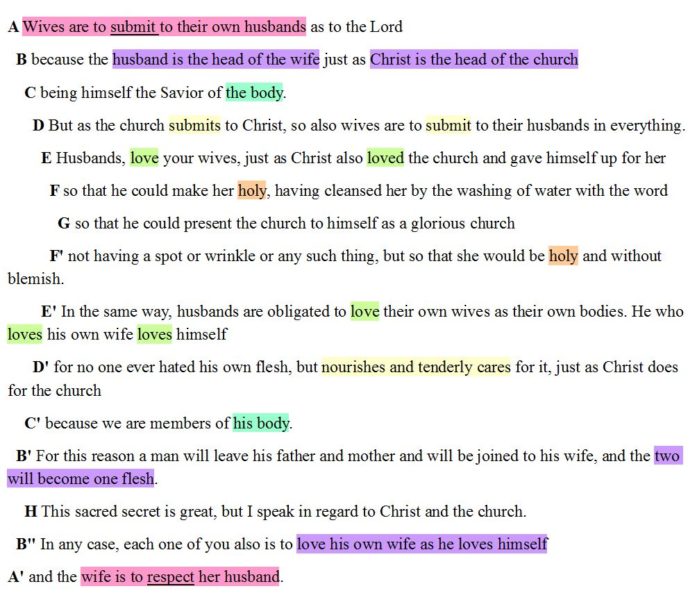
This is part of a series on patriarchy, headship, and submission. See this index.
Mnemonic Devices
In English we have many linguistic structures that help us remember the content of a piece of writing, especially when it is read out loud. These mnemonic devices are literary devices include acronyms, rhyming, and various other forms of grouping. There are at least nine types.
When the books contained in the Bible were first written, most were intended to be read out loud to an audience. Consequently, many formal linguistic structures were used to aide in memory retention. One of the more obvious is repetition, which is quite common especially in the poetry sections of the Old Testament.
These devices allowed for illiterate ancient listeners to accurately memorize Scripture and transmit it orally without significant corruption, much like most Christians can quote John 3:16 without error throughout their entire lives.
The Structure of Ephesians 5
The book of Ephesians is not a simple, unstructured letter, but shows linguistic structure typical of ancient writings that would be read out-loud to the illiterate. These structures serve the same purpose as the mnemonic devices described above. This is especially important when one approaches the section on submission in Ephesians 5.
The entire chapter of Ephesians 5 is part of the same large “paragraph.” Paul is speaking to the church about the proper (and improper) ways of living and giving advice and commands. While there is a lot that can be said, let’s begin our discussion at verse 18. Why verse 18? Because verse 18 is the beginning of the sentence that doesn’t end—in the English language sense—until at least verse 23, perhaps later.
(v18) And don’t get drunk with wine, which leads to reckless living, but be filled with the Spirit:
(v19) speaking to one another in psalms, hymns, and spiritual songs
(v19) singing and be making music with your heart to the Lord
(v20) giving thanks always for everything to God the Father in the name of our Lord Jesus Christ
(v21ff) submitting …
[v21 through v33]
The first thing to note is there is only pure verb in this sentence—”be filled”—followed by a successive list of participles—speaking, singing, making, giving, submitting—that fall under the umbrella of the original verb. A participle is a word that functions partially as an adjective and a verb. Formally it is
A word derived from a verb and used as an adjective
This language in Ephesians is used so that the listener understands that these acts (the participle acting like a verb)—speaking, singing, making, giving, submitting—all describe (the participle acting like an adjective) ways to be filled with the Spirit. These acts do not stand in a vacuum by are related under that common verb.
But the structure of the passage changes abruptly after verse 20. The series of participles ends (in verse 21), and a discussion about husbands and wives takes place.
This new section utilizes a different, but very common, literary device known as a chiastic pattern. In a chiasmus, words and phrases are repeated in a specific pattern—usually pairs, in the ancient style—to group related thoughts and to emphasize the most important themes.

In this example, the more indented the chiasmus is, the more emphasized the content, so A/A’ (instructions to wives) is less important than E/E’ (instructions to husbands), with the whole thing culminating in importance with F/F’ (making the church holy), and finally G (Christ presenting his bride to himself), the central theme (which isn’t repeated!).
The addition of a chiastic structure—establishing a self-contained section—is why some translators add a paragraph break (a new section heading) between verse 20 and 21 (e.g. the NIV), even though the “sentence” continues. However, other translators put a break between verses 21 and 22. When I wrote “Chiastic Structure of Ephesians 5:22-33“, I made that same mistake.
First, notice that “A” is the beginning of verse 22, not verse 21. Breaking this up is a problem, because the underlined word respect in A’ is the same word as fear in verse 21 (not shown here). It is clear that A and A’ are matched in the chiastic structure by their use of that single word, not submit as I seem to indicate above. Thus the A in the chiastic structure is both verse 21 and verse 22.
Second, the word submit only exists in the original Greek in verse 21 as part of a single sentence which continues in verse 22. Breaking them up is a translation error.
Third, the entire chiastic structure is framed around the word fear in what is known as an inclusio, another literary device. This is why v21 through v33 are indented in the structure above that starts with v18. They are still part of the series of participles, a detailed discussion within it. The chiastic structure and the inclusio tell the listener that he should treat this as a single expansion of the topic within the context of the wider discussion.
All of these literary devices serve as mnemonic devices to allow listeners to understand and remember what Paul wanted to say.
The Meaning of Ephesians 5
So what does this all mean? Let’s read what Ephesians 5:21-22 says…
…Husbands, love your wives, just as Christ loved the church…”
— comment by thedeti @ SigmaFrame, “The Tennant Authority Structure”
While my previous word, passage, topical, and historical studies of headship and submission show that this explanation cannot be sustained, it is further confirmed by how the literary structure of the passage excludes that explanation.

Pingback: Men Act; Women Acted Upon
Pingback: On Women, Part 4
Pingback: "It's a Military Term"
Pingback: On Sacrifice and Sanctification